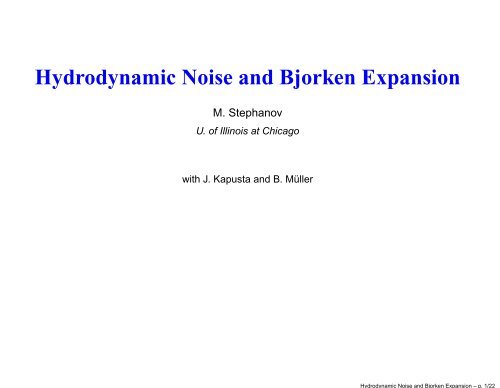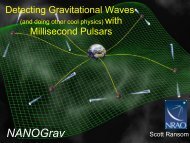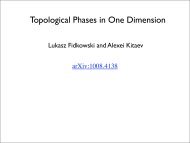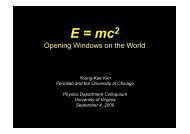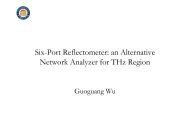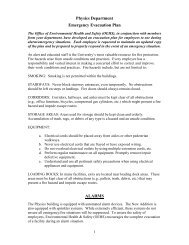Hydrodynamic Noise and Bjorken Expansion
Hydrodynamic Noise and Bjorken Expansion
Hydrodynamic Noise and Bjorken Expansion
You also want an ePaper? Increase the reach of your titles
YUMPU automatically turns print PDFs into web optimized ePapers that Google loves.
<strong>Hydrodynamic</strong> <strong>Noise</strong> <strong>and</strong> <strong>Bjorken</strong> <strong>Expansion</strong> – p. 1/22<br />
<strong>Hydrodynamic</strong> <strong>Noise</strong> <strong>and</strong> <strong>Bjorken</strong> <strong>Expansion</strong><br />
M. Stephanov<br />
U. of Illinois at Chicago<br />
with J. Kapusta <strong>and</strong> B. Müller
<strong>Hydrodynamic</strong> <strong>Noise</strong> <strong>and</strong> <strong>Bjorken</strong> <strong>Expansion</strong> – p. 2/22<br />
Strong interactions<br />
Nuclear force holds protons/neutrons together<br />
in a nucleus.<br />
This is the force that makes the Sun shine.<br />
Like van-der-Waals forces in ED, nuclear force is<br />
a “shadow” of a much stronger force.<br />
This force holds proton’s constituents together.<br />
Like in ED the strong force field can carry waves – gluons.<br />
Unlike ED the gluon-mediated force grows with separation. Confinement.<br />
The “charge” comes in 3 varieties – colors.<br />
The QFT of the gluons <strong>and</strong> quarks – Quantum Chromodynamics.<br />
QCD is the most elegant piece of the St<strong>and</strong>ard Model.<br />
The quest to “solve” QCD produced the most advanced ideas <strong>and</strong> tools in<br />
Theoretical Physics – from Lattice to String theory.
<strong>Hydrodynamic</strong> <strong>Noise</strong> <strong>and</strong> <strong>Bjorken</strong> <strong>Expansion</strong> – p. 3/22<br />
Quark-Gluon Plasma<br />
Can the gas of color-neutral nucleons be “ionized”?<br />
Can the (confined) quarks be set free by heating the gas of hadrons to<br />
extremely high temperature, revealing the QCD constituents <strong>and</strong> the “color”<br />
forces?<br />
Quark-Gluon Plasma.<br />
What temperature would be needed?<br />
k B T = c/R proton ∼ 200 MeV (over 10 5 of T in the Sun’s core)<br />
The Universe was that hot (<strong>and</strong> hotter) at the beginning.<br />
Today we can recreate such conditions by smashing large atomic nuclei.<br />
RHIC<br />
LHC
<strong>Hydrodynamic</strong> <strong>Noise</strong> <strong>and</strong> <strong>Bjorken</strong> <strong>Expansion</strong> – p. 4/22<br />
Lattice<br />
QCD is a quantum field theory, i.e., everything measurable<br />
is, in principle, predictable: hadron masses,<br />
scattering amplitudes, equation of state, etc.<br />
The theory says “calculate path integral” (Feynman), i.e., a weighted sum<br />
over all space-time trajectories of the variables, i.e., the fields.<br />
It is an infinitely difficult problem (for a non-trivial theory), because the number<br />
of variables (<strong>and</strong> integrations) is ∞.<br />
Lattice approach allows to reach this infinity gradually, by starting on a<br />
coarse, finite lattice <strong>and</strong> refining it. QCD on the lattice (Wilson).<br />
The question the lattice can answer is: what happens in QCD at finite T in<br />
equilibrium?<br />
E.g., how does energy density, pressure, entropy, etc. depend on T ?<br />
Does hardron gas become QGP at T ∼ 200 MeV? Yes, it does.<br />
But non-equilibrium (e.g., transport) properties are still a challenge for today’s<br />
lattice methods.
<strong>Hydrodynamic</strong> <strong>Noise</strong> <strong>and</strong> <strong>Bjorken</strong> <strong>Expansion</strong> – p. 5/22<br />
Heavy-ion collision<br />
Heavy-ion collision creates matter in not quite as<br />
static a state as what we can study on the lattice.<br />
The created fireball evolves (explodes): “little bang”.<br />
Transport properties are important.<br />
Detectors measure the particle type <strong>and</strong> momentum<br />
distributions in the final state, when the density<br />
drops so that the particles free-stream – freeze-out.<br />
dN/dy<br />
10<br />
2<br />
s NN<br />
=200 GeV<br />
10<br />
This state is thermal, with temperature about<br />
160 MeV.<br />
Similarity to BB <strong>and</strong> CMB.<br />
1<br />
−1<br />
10<br />
Data<br />
π +<br />
STAR<br />
PHENIX<br />
BRAHMS<br />
Model, χ 2 /N df<br />
=29.7/11<br />
3<br />
T=164 MeV, µ = 30 MeV, V=1950 fm<br />
b<br />
−<br />
π<br />
+<br />
K<br />
−<br />
K p p Λ Λ<br />
Ξ −<br />
Ξ +<br />
Ω φ d d K* Σ * Λ*
<strong>Hydrodynamic</strong> <strong>Noise</strong> <strong>and</strong> <strong>Bjorken</strong> <strong>Expansion</strong> – p. 6/22<br />
<strong>Hydrodynamic</strong> description<br />
The hydrodynamic description of the heavy ion collision<br />
goes back to L<strong>and</strong>au (1953).<br />
Glauber<br />
Approach: take the equation of state, set<br />
initial conditions, <strong>and</strong> solve hydrodynamic<br />
equations to get particle yields, spectra, etc.<br />
Good agreement with data.<br />
v 2<br />
0.1<br />
0.08<br />
η/s=10 -4<br />
0.06<br />
0.04<br />
η/s=0.08<br />
0.02<br />
η/s=0.16<br />
PHOBOS<br />
Sensitive to viscosity. (Azimuthal asymmetry) 0<br />
0 100 200 300 400<br />
N Part<br />
Recent interest is due to the remarkably small implied value of viscosity.<br />
Expressed as the ratio η/s it is much smaller than one would predict in a<br />
weakly-coupled QCD plasma (Arnold-Moore-Yaffe, 2003).<br />
The ratio η/s is a measure of the coupling strength.<br />
For weak coupling η s ∼ 1<br />
– must be large.<br />
(coupling)<br />
2<br />
AdS/CFT calculation in SYM theory at infinite coupling: η/s = 1/(4π).<br />
QGP at RHIC is not a gas, but a very good (perfect?) liquid. sQGP.
<strong>Hydrodynamic</strong> <strong>Noise</strong> <strong>and</strong> <strong>Bjorken</strong> <strong>Expansion</strong> – p. 7/22<br />
Fluctuations <strong>and</strong> viscosity<br />
Can viscosity be measured in a different,<br />
complementary way?<br />
Idea: fluctuation-dissipation theorem requires<br />
fluctuations (hydrodynamic noise) <strong>and</strong><br />
dissipation (viscosity) to be proportional to<br />
each other.<br />
The magnitude of fluctuations (correlations)<br />
can be measured.<br />
The hydrodynamic correlations can be determined<br />
theoretically <strong>and</strong> depend on viscosity.<br />
Correlations over large ∆η are induced<br />
by local fluctuations (hydrodynamic noise)<br />
propagating with the speed of sound.<br />
Similarity to the fluctuations in the CMB.<br />
KΗ<br />
3.0<br />
2.5<br />
2.0<br />
1.5<br />
1.0<br />
0.5<br />
0.0<br />
0.5<br />
0 1 2 3 4 5 6<br />
Η
<strong>Hydrodynamic</strong> <strong>Noise</strong> <strong>and</strong> <strong>Bjorken</strong> <strong>Expansion</strong> – p. 8/22<br />
Relativistic <strong>Hydrodynamic</strong>s<br />
<strong>Hydrodynamic</strong>s: the effective theory for slow, long scale variations of the variables<br />
characterizing local thermal equilibrium.<br />
Variables: conserved quantities – energy, momentum, charge densities.<br />
Equations: conservation laws – ∇ µ T µν = 0, ∇ µ J µ = 0.<br />
Defining variables involves chosing the local rest frame: T 00 = ǫ, J 0 = n.<br />
Simplifying choice(s): T 0i = 0 (L<strong>and</strong>au) or J i = 0 (Eckart).<br />
Use 3 components of u µ instead of momentum density.<br />
The 4 equations involve 10 components of T µν . Thus the remaning 6 must be<br />
expressed in terms of ǫ <strong>and</strong> u µ .<br />
In equilibrium the medium is homogeneous <strong>and</strong> (T 00 = ǫ, T 11 = p, . . . )<br />
T µν<br />
eq = ǫu µ u ν − P(ǫ)(g µν − u µ u ν ).<br />
∇ µ T µν<br />
eq = 0 is ideal hydrodynamics.
<strong>Hydrodynamic</strong> <strong>Noise</strong> <strong>and</strong> <strong>Bjorken</strong> <strong>Expansion</strong> – p. 9/22<br />
Viscous hydrodynamics<br />
Deviations from equilibrium are due to (slow) spatial variations of ǫ <strong>and</strong> u µ . I.e.,<br />
T µν = T µν<br />
eq + (gradients of ǫ <strong>and</strong> u µ )<br />
| {z }<br />
∆T µν<br />
Subject to ∆T µν u ν = 0 (T µν u ν = ǫu µ by definition), the most general form is<br />
(∆ µ = h µν ∇ ν , h µν = g µν − u µ u ν )<br />
∆T µν = η<br />
»<br />
∆ µ u ν + ∆ ν u µ − 2 –<br />
3 hµν (∇ · u) − ζh µν (∇ · u)<br />
Second law of thermodynamics for entropy s = β(ǫ + P) flow<br />
∇ µ (su µ ) = −β∆T µν ∇ µ u ν = η<br />
2T<br />
»<br />
∆ µ u ν + ∆ ν u µ − 2 – 2<br />
3 hµν (∇ · u) + ζ T<br />
(∇ · u)2
<strong>Hydrodynamic</strong> <strong>Noise</strong> <strong>and</strong> <strong>Bjorken</strong> <strong>Expansion</strong> – p. 10/22<br />
Fluctuations <strong>and</strong> <strong>Noise</strong><br />
So far hydro. eqns. describe evolution of the average values of the variables. In a<br />
thermodynamic ensemble the variables fluctuate.<br />
The origin of the noise is local, but these fluctuations propagate according to<br />
hydrodynamic equations. I.e., hydrodynamics can describe long-range<br />
correlations.<br />
This means<br />
∆T µν = ∆T µν<br />
visc + Sµν .<br />
Locality means ˙ S µν (x)S αβ (0) ¸ ∼ δ 4 (x). The magnitude is determined by the<br />
condition that the equilibrium distribution is given by e S (Einstein).
<strong>Hydrodynamic</strong> <strong>Noise</strong> <strong>and</strong> <strong>Bjorken</strong> <strong>Expansion</strong> – p. 11/22<br />
Fluctuations <strong>and</strong> <strong>Noise</strong><br />
Generically, for a system of many variables x i , obeying<br />
ẋ i = − X j<br />
γ ij X j + y i<br />
where X j = −∂S/∂x i , the required noise is 〈 y i (t)y j (0) 〉 = (γ ij + γ ji )δ(t).<br />
Applying to x i ∼ ǫ, u µ one finds<br />
D<br />
E<br />
S µν (x)S αβ (0) = 2T<br />
» “<br />
η h µα h νβ + h µβ h να” +<br />
„ζ − 2 « –<br />
3 η h µν h αβ δ 4 (x)<br />
This, with T µν = T µν<br />
eq + ∆T µν<br />
visc + Sµν defines a system of stochastic equations<br />
∇ µ T µν = 0.<br />
The correlation functions of T µν can be now calculated by solving in terms of S µν .<br />
Usually, this is applied to fluctuations around a static equilibrium solution. Our goal<br />
is to apply this to determine correlations in an exp<strong>and</strong>ing fireball.
<strong>Hydrodynamic</strong> <strong>Noise</strong> <strong>and</strong> <strong>Bjorken</strong> <strong>Expansion</strong> – p. 12/22<br />
<strong>Bjorken</strong> expansion<br />
<strong>Bjorken</strong> (1983) suggested that the central region of the heavy-ion collisions can be<br />
described by a solution of the hydrodynamic equations which is boost-invariant.<br />
The <strong>Bjorken</strong> flow is conveniently viewed in <strong>Bjorken</strong> coordinates:<br />
t<br />
t = τ cosh ξ <strong>and</strong> z = τ sinh ξ.<br />
In these coordinates the fluid is at rest locally: u µ = (1, 0,0 ⊥ ) Bj .<br />
z<br />
The average quantities depend only on τ. But the fluctuations depend also on ξ<br />
<strong>and</strong> x ⊥ , e.g., ǫ = ǫ 0 (τ) + δǫ(τ, ξ, x ⊥ ).<br />
We integrate (average) over x ⊥ <strong>and</strong> consider, effectively, a 1+1 dimensional<br />
problem. In this case S µν u ν = 0 means<br />
where f is r<strong>and</strong>om noise (w = ǫ + p)<br />
〈 f(ξ 1 , τ 1 )f(ξ 2 , τ 2 ) 〉 = 2T(τ 1)<br />
Aτ 1 w 2 (τ 1 )<br />
S µν = w(τ)f(ξ, τ)h µν<br />
» 4<br />
3 η(τ 1) + ζ(τ 1 )–<br />
δ (τ 1 − τ 2 ) δ (ξ 1 − ξ 2 )
<strong>Hydrodynamic</strong> <strong>Noise</strong> <strong>and</strong> <strong>Bjorken</strong> <strong>Expansion</strong> – p. 13/22<br />
<strong>Hydrodynamic</strong> equations<br />
The only nontrivial function is ǫ(τ), <strong>and</strong> it obeys<br />
d(τs)<br />
dτ<br />
= ν<br />
τT s<br />
I.e., entropy per unit rapidity, τsA, increases only due to viscosity.<br />
Convenient notation: ν ≡ (4η/3 + ζ)/s.<br />
E.g., for s ∼ T 3 ⇒ T ∼ τ −1/3 + visc. corrections
<strong>Hydrodynamic</strong> <strong>Noise</strong> <strong>and</strong> <strong>Bjorken</strong> <strong>Expansion</strong> – p. 14/22<br />
<strong>Hydrodynamic</strong> equations for fluctuations<br />
Fluctuations, ǫ = ǫ 0 (τ) + δǫ(ξ, τ), u z = sinh(ξ + ω(ξ, τ)), obey<br />
τ ∂δǫ<br />
∂τ<br />
+ δw + wf −<br />
δ(νs)<br />
τ<br />
+<br />
h<br />
w − 2 νs<br />
τ<br />
i ∂ω<br />
∂ξ = 0<br />
τ ∂<br />
∂τ<br />
h “<br />
ω<br />
w − νs<br />
τ<br />
”i “<br />
+2ω<br />
w − νs<br />
τ<br />
Easy to obtain by P → P + wf − νs<br />
τ<br />
”<br />
+ ∂ ∂ξ<br />
»<br />
δP + wf − δ(νs)<br />
τ<br />
“ ”<br />
1 + ∂ω<br />
∂ξ<br />
–<br />
− νs<br />
τ<br />
in ideal equations.<br />
∂ 2 ω<br />
∂ξ 2 = 0 .<br />
Convenient variable: ρ ≡ δs/s = δǫ/w. Also, Fourier transform ξ → k.<br />
Solve for X = ρ, ω in terms of f.<br />
˜X(k, τ) = −<br />
Z τ<br />
τ 0<br />
dτ ′<br />
τ ′ ˜GX (k; τ, τ ′ ) ˜f(k, τ ′ )<br />
Then calculate correlations 〈 XY 〉 using known 〈 ff 〉.
ξ 1 ξ 2<br />
τ f<br />
<strong>Hydrodynamic</strong> <strong>Noise</strong> <strong>and</strong> <strong>Bjorken</strong> <strong>Expansion</strong> – p. 15/22<br />
Correlations<br />
The equal-(proper)time correlation function at the freeze-out time τ f :<br />
C XY (ξ 1 − ξ 2 ; τ f ) ≡ 〈 X(ξ 1 , τ f ) Y (ξ 2 , τ f ) 〉 = 2 A<br />
where the Fourier transform of G XY (ξ; τ f , τ) is given by<br />
Z τ f<br />
τ 0<br />
dτ<br />
τ 3 ν(τ)<br />
w(τ) G XY (ξ 1 − ξ 2 ; τ f , τ) , (1)<br />
Thus<br />
˜G XY (k; τ f , τ) ≡ ˜G X (k; τ f , τ) ˜G Y (−k; τ f , τ) . (2)<br />
G XY (ξ 1 − ξ 2 ; τ f , τ) =<br />
Z ∞<br />
−∞<br />
dξG X (ξ 1 − ξ; τ f , τ)G Y (ξ 2 − ξ; τ f , τ) . (3)<br />
ξ<br />
τ
<strong>Hydrodynamic</strong> <strong>Noise</strong> <strong>and</strong> <strong>Bjorken</strong> <strong>Expansion</strong> – p. 16/22<br />
Solution: inviscid case, linear EOS<br />
with (for inviscid case)<br />
τ ∂ ˜ψ<br />
∂τ + D ˜ψ + ñ = 0,<br />
„˜ρ˜ω«<br />
„ « 0 ik<br />
˜ψ = ; D = D 0 ≡ 2 2 , ñ =<br />
ikv s 1 − v s<br />
„ « 1<br />
ik<br />
˜f .<br />
˜ψ(k, τ) = −<br />
Z τ<br />
τ 0<br />
dτ ′<br />
τ ′ Ũ(k; τ, τ ′ )ñ(k, τ ′ )<br />
where<br />
Ũ(k; τ, τ ′ ) = T exp<br />
j Z τ<br />
ff<br />
dτ ′′<br />
−<br />
τ ′ τ D(k, τ ′′ )<br />
′′<br />
If v 2 s ≡ dP/dǫ = const (linear EOS):<br />
Ũ(k; τ, τ ′ ) = (τ „ «<br />
′ /τ) λ − λ+ −ik<br />
2<br />
λ + − λ − −ikv s −λ −<br />
− (τ „ «<br />
′ /τ) λ + λ− −ik<br />
2<br />
λ + − λ − −ikv s −λ +<br />
.<br />
D ˜ψ ± = λ ± ˜ψ± : λ ± = α ± β; α = 1 2<br />
`1 − vs<br />
2´ ; β = p α 2 − v s2 k 2 .
<strong>Hydrodynamic</strong> <strong>Noise</strong> <strong>and</strong> <strong>Bjorken</strong> <strong>Expansion</strong> – p. 17/22<br />
Response functions <strong>and</strong> sound horizon<br />
˜G ρ (k; τ, τ ′ ) =<br />
„ τ<br />
′<br />
τ<br />
« α »<br />
cosh `β<br />
„<br />
ln(τ/τ ′ α + k<br />
2<br />
)´ +<br />
«sinh `β ln(τ/τ )´–<br />
′<br />
β<br />
Note: β = √ α 2 − v s2 k 2 is pure imaginary if |k| > (1 − v s 2 )/2v s .<br />
Acoustic oscillations.<br />
G X – meromorphic function of k. Sole singularity is at k = ∞.<br />
Cauchy theorem gives:<br />
G X (ξ; τ, τ ′ ) = 0 when |ξ| > v s ln(τ/τ ′ ) — sound horizon<br />
In the local rest frame the velocity of the front, τdξ/dτ, equals v s .
<strong>Hydrodynamic</strong> <strong>Noise</strong> <strong>and</strong> <strong>Bjorken</strong> <strong>Expansion</strong> – p. 18/22<br />
Singularities at the sound horizon<br />
Oscillatory behavior at large k translates into sound front in ξ:<br />
G ρρ (ξ; τ f , τ) =<br />
1<br />
4v s<br />
2<br />
Z ∞<br />
dk<br />
−∞ 2π eikξ ˜Gρ (k; τ f , τ) ˜G ρ (−k; τ f , τ) →<br />
„ « 2α τ ˆδ′′ (ξ − 2v s ln(τ f /τ)) + δ ′′ (ξ + 2v s ln(τ f /τ)) − 2δ ′′ (ξ)˜<br />
τ f<br />
ξ = 2v s ln(τ f /τ)<br />
τ f<br />
τ
<strong>Hydrodynamic</strong> <strong>Noise</strong> <strong>and</strong> <strong>Bjorken</strong> <strong>Expansion</strong> – p. 19/22<br />
The wake<br />
G reg<br />
ρρ ≡ G ρρ − G sing<br />
ρρ<br />
GΡΡ reg<br />
0.30<br />
0.25<br />
0.20<br />
0.15<br />
0.10<br />
0.05<br />
0.00<br />
0.05<br />
0 2 4 6 8<br />
v s 2 = 1/3 <strong>and</strong> ln(τ f /τ) = 2, 4, 6<br />
Ξ<br />
GΡΡ sing<br />
1.5<br />
1.0<br />
0.5<br />
0.0<br />
0.5<br />
1.0<br />
0 2 4 6 8<br />
σ 2 = 0.1<br />
Ξ<br />
If the dispersion was linear, there would only be the sound front. However,<br />
ω = iλ ± = iα ± √ v s2 k 2 − α 2 .<br />
Also note that one eigenvalue λ − ∼ k 2 , for k → 0.<br />
Diffusion-like, but no dissipation.<br />
G ρρ becomes Gaussian at large τ f /τ. Width ˙ ∆ξ 2 ¸ = 2v s 2 /α · ln(τ f /τ).<br />
Sum rule: R ∞<br />
−∞ dξ G ρρ(ξ; τ f , τ) = 1.
<strong>Hydrodynamic</strong> <strong>Noise</strong> <strong>and</strong> <strong>Bjorken</strong> <strong>Expansion</strong> – p. 20/22<br />
Viscosity <strong>and</strong> taming of singularities<br />
For ν = const can be solved by perturbation in<br />
Not assuming k 2 × ν to be small.<br />
τT<br />
ν<br />
τT ≪ 1.<br />
˜G ρ (k; τ, τ ′ ) =<br />
„ τ<br />
′<br />
τ<br />
« α »<br />
cosh `β ln(τ/τ ′ )´ +<br />
„α + k 2 + νk2<br />
× exp<br />
»− νk2<br />
4α<br />
« –<br />
sinh(β ln(τ/τ ′ ))<br />
2τ ′ T(τ ′ )<br />
„ 1<br />
τ ′ T(τ ′ ) − 1<br />
τT(τ)<br />
β<br />
«–<br />
For G XX (ξ; τ f , τ)) – Gaussian smearing with width<br />
σ 2 = ν α<br />
„ 1<br />
τT − 1<br />
τ f T f<br />
«
Cooper-Frye prescription:<br />
Freeze-out<br />
Z<br />
p 0 dN s<br />
d 3 p = d s d 3 σ µ p µ f s (x, p); f s (x,p) =<br />
Σ f<br />
“ ” −1<br />
e p·u/T ± 1<br />
Fluctuations ρ <strong>and</strong> ω (i.e., T <strong>and</strong> u) translate into δN:<br />
δ<br />
„ dN<br />
dη<br />
«<br />
= d sAτ f T f<br />
3<br />
(2π) 2<br />
Z<br />
dξ ρ v s 2 + ω tanh(η − ξ)<br />
cosh 2 (η − ξ)<br />
Γ<br />
„<br />
4, m «<br />
0<br />
cosh(η − ξ)<br />
T f<br />
Translation from ξ to η leads to additional (thermal) smearing.<br />
fi<br />
δ dN δ dN fl fi dN<br />
dη 1 dη 2 dη<br />
fl −1<br />
=<br />
45d s<br />
4π 4 N eff (T 0 )<br />
„ « −2<br />
ν T<br />
2 vs −2<br />
0<br />
2<br />
K(∆η) ,<br />
T f τ f T f<br />
3.0<br />
2.5<br />
2.0<br />
KΗ<br />
1.5<br />
1.0<br />
0.5<br />
0.0<br />
0.5<br />
0 1 2 3 4 5 6<br />
Η<br />
<strong>Hydrodynamic</strong> <strong>Noise</strong> <strong>and</strong> <strong>Bjorken</strong> <strong>Expansion</strong> – p. 21/22
<strong>Hydrodynamic</strong> <strong>Noise</strong> <strong>and</strong> <strong>Bjorken</strong> <strong>Expansion</strong> – p. 22/22<br />
Conclusions <strong>and</strong> Outlook<br />
<strong>Hydrodynamic</strong>s predicts long range correlations induced by thermal noise.<br />
Wake: magnitude is proportional to ν. Nontrivial consequence of expansion.<br />
Magnitude of correlations in static equilibrium is determined by the static<br />
(thermodynamic) quantities only.<br />
Ridge: need to detemine φ-dependence. Expect a narrow (thermal) peak.<br />
More realistic (numerical) calculations need to be compared with experiment.


